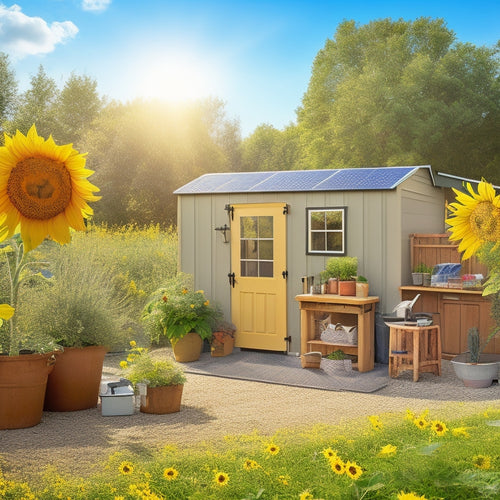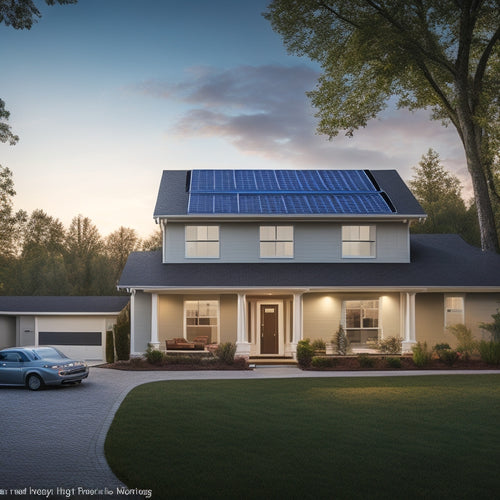
Diy Solar System With Battery Backup
Share
When you integrate a battery storage system with your DIY solar setup, you can reduce your reliance on the grid by up to 50% or more, depending on your energy usage, and enjoy a consistent power supply even during nighttime or extended outages. With a well-designed battery backup system, you'll have energy independence and minimize energy waste. Proper system sizing is essential to meet your energy needs, and regular maintenance practices will extend the lifespan of your energy storage system. By optimizing your DIY solar system with a battery backup, you'll be on your path to achieving sustainable energy and significant cost savings - and that's just the beginning of your energy independence expedition.
The Essentials
- A well-designed DIY solar system with battery backup ensures energy independence and reliability during grid outages and nighttime usage.
- Proper system sizing and load calculation are crucial to meet energy needs effectively and minimize energy waste.
- High-efficiency inverters and MPPT technology maximize energy conversion and harvesting capabilities, reducing energy loss and heat generation.
- Integration of a battery backup system reduces grid reliance, lowering electricity bills and providing reliable power during outages.
- Regular maintenance practices extend the lifespan of energy storage systems, which can last between 5-15 years depending on type and usage.
Energy Independence At Night
You've invested in a DIY solar system, but what about when the sun goes down?
You'll need a reliable energy storage solution to power through the darkness. By integrating a battery storage system into your DIY setup, you can store excess energy generated during the day and use it at night, reducing your reliance on the grid and energy waste.
Your energy independence at night depends on a well-designed battery backup system that can supply your energy needs during extended periods of darkness.
Powering Through Darkness
With darkness falling, your DIY solar system's energy generation comes to a halt, but that doesn't mean you have to sacrifice power - not with a well-designed battery backup system, at least. This is where your system's energy independence really shines, allowing you to power through the night without relying on the grid.
To guarantee a seamless shift, it's essential to evaluate your solar panel placement and battery lifespan. Properly angled and placed solar panels will maximize energy generation during the day, while a high-quality battery with a long lifespan will store excess energy for later use.
Here's a comparison of different battery types and their lifespans:
| Battery Type | Lifespan (Years) | Depth of Discharge (DOD) |
|---|---|---|
| Lead-Acid | 5-7 | 50% |
| Lithium-Ion | 10-15 | 80% |
| Nickel-Cadmium | 10-15 | 80% |
| Nickel-Metal Hydride | 10-15 | 80% |
| Sodium-Ion | 10-15 | 80% |
Energy Storage Solutions
Reliability is the cornerstone of energy independence, and it's achieved through a well-designed energy storage solution. When choosing a battery type, you'll need to take into account factors like depth of discharge, cycle life, and efficiency ratings.
Lead-acid batteries are a cost-effective option, while lithium-ion batteries offer higher energy density and longer lifetimes. By incorporating a home battery storage system, you can reduce your reliance on the grid during power outages and lower your electricity bills by storing excess energy generated by your solar panels or wind turbines.
System sizing is critical to guarantee you have enough energy storage to meet your needs. You'll need to analyze your usage patterns and determine the required capacity. Energy management systems can help you monitor and control your energy usage, making sure you're getting the most out of your solar system.
When installing your energy storage solution, follow proper installation tips to maintain safety and efficiency. Regular maintenance practices, such as checking battery health and updating software, are essential to extend the lifespan of your system.
Conduct a thorough cost analysis to determine the best solution for your budget. Additionally, take into account grid interaction and how it may impact your energy management strategy.
Reduced Carbon Footprint Guaranteed
By utilizing solar energy, you're switching to an eco-friendly source that greatly reduces your reliance on fossil fuels, thereby minimizing carbon emissions.
This shift translates to a considerable decrease in your carbon footprint, making your DIY solar system a guilt-free alternative.
With the help of residential solar panels, you can generate clean energy and reduce your energy bills.
As you generate clean energy, you'll be offsetting the equivalent of planting trees or reducing gasoline consumption, making a tangible impact on the environment.
Eco-Friendly Energy Sources
In utilizing renewable energy, you can considerably reduce your carbon footprint and contribute to a more sustainable future. By employing natural resources like sunlight, wind, and water, you can generate electricity without harming the environment.
When it comes to solar energy, you have various solar panel types to choose from, including monocrystalline, polycrystalline, and thin-film panels. Each type has its own advantages and disadvantages, so it's crucial to select the one that best suits your needs and budget.
Renewable energy systems, like DIY solar systems with battery backup, offer a reliable and efficient way to power your home or business. By investing in eco-friendly energy sources, you're not only reducing your carbon footprint but also gaining energy independence.
You'll no longer be tied to the grid, and you'll have a steady supply of clean energy. With the right system in place, you can enjoy the benefits of renewable energy while contributing to a more sustainable future.
Carbon Emissions Reduction
Since you've decided to employ the power of solar energy, you're already taking a notable step towards reducing your carbon footprint. By utilizing renewable energy, you're decreasing your reliance on fossil fuels and subsequently minimizing the amount of greenhouse gas emissions released into the atmosphere.
This conscious effort towards sustainability will considerably contribute to a reduced carbon footprint, ultimately benefiting the environment and future generations.
In addition to solar energy, you can further amplify your eco-friendly initiatives by incorporating carbon offsetting strategies into your daily life. These strategies involve compensating for your carbon emissions by investing in projects that reduce greenhouse gas emissions elsewhere, such as reforestation or renewable energy projects.
By adopting sustainable energy initiatives and carbon offsetting strategies, you'll be well on your journey to achieving a net-zero carbon footprint.
As you continue to investigate the domain of DIY solar systems with battery backup, remember that every small step counts in the fight against climate change.
Inverter Efficiency Matters Most
When you're building a DIY solar system with battery backup, you'll want to prioritize inverter efficiency to maximize your energy harvest.
A high-efficiency inverter guarantees a high power conversion ratio, which means more of the sun's energy is converted into usable electricity. This is particularly important when using deep cycle batteries as they require efficient charging to maintain their lifespan.
Power Conversion Ratio
Your inverter's power conversion ratio is an essential factor in determining the overall efficiency of your DIY solar system with battery backup. This ratio, typically represented as a percentage, indicates how efficiently your inverter converts DC power from your solar panels or batteries to AC power for your household appliances.
A higher power conversion ratio means less energy is wasted as heat, resulting in more efficient energy harvesting and reduced energy losses.
When optimizing your DIY solar system's efficiency, it's vital to prioritize power conversion. Look for an inverter with a high power conversion ratio, typically above 95%. This guarantees that most of the energy generated by your solar panels is converted to usable AC power.
Additionally, consider the type of inverter technology used, as some, like MPPT (Maximum Power Point Tracking) inverters, are more efficient than others.
Maximum Energy Harvest
In optimizing your DIY solar system with battery backup, maximum energy harvest is vital, and inverter efficiency plays a key role in achieving this goal. You want to guarantee that your system can generate the most power possible from the available sunlight.
Inverter efficiency is significant because it directly affects the amount of energy you can harvest from your solar panels. A high-efficiency inverter will minimize energy losses, resulting in more power available for your backup system.
To maximize energy harvest, it's important to evaluate solar panel orientation. Proper orientation guarantees that your panels receive peak sunlight, generating more power.
You should also assess the inverter's maximum power point tracking (MPPT) capability, which helps to enhance energy production. Additionally, a high-efficiency inverter will reduce heat generation, which can prolong your battery lifespan.
Match Wattage to Load
You'll need to calculate your power load to guarantee your solar system can handle the energy requirements of your appliances and devices, which is essential for energy independence and reducing your reliance on the grid renewable energy systems.
This involves adding up the wattage of each item and accounting for any surge requirements, as you want to verify your system can handle the load during peak usage times.
Once you have this total, you can perform a wattage compatibility check to confirm that your solar system's output matches your load's needs.
Power Load Calculation
Accurate power load calculation is essential to confirm your DIY solar system can support the required electrical load. To do this, you'll need to determine the total power consumption of your appliances and devices.
Start by making a list of all the devices you want to power with your solar system, along with their respective wattage ratings. Next, calculate the total daily energy consumption in watt-hours (Wh) by multiplying the wattage of each device by the number of hours it's used per day. Add up the total daily energy consumption to determine your overall power load.
This calculation will help you determine the suitable solar panel sizing and battery capacity for your system. A larger power load will require more solar panels and a higher-capacity battery to confirm a reliable supply of energy. Conversely, a smaller power load will require fewer solar panels and a lower-capacity battery.
Wattage Compatibility Check
Energy harmony is essential when designing a DIY solar system, and a wattage compatibility check confirms that your system's components are in perfect sync.
You've calculated your power load, now it's time to verify that your solar panels, charge controller, inverter, and battery bank are compatible regarding wattage. A wattage mismatch can lead to inefficient energy production, reduced system lifespan, or even system failure.
To avoid this, you'll need to match the wattage of your solar panels to your charge controller and inverter. Your charge controller should be able to handle the maximum power output of your solar panels, while your inverter should be compatible with the voltage and current output of your battery bank.
Load balancing is critical to verify that your system operates within its design parameters. By performing a wattage compatibility check, you'll confirm that your DIY solar system operates efficiently, reliably, and safely, giving you the freedom to generate your own clean energy.
Lower Maintenance Costs
You'll cut down on energy expenditure with your DIY solar system, as it generates power locally and reduces your reliance on the grid.
This means you'll spend less on electricity bills, freeing up resources for other important expenses.
Reduced Energy Expenditure
Efficiency is the cornerstone of a well-designed DIY solar system with battery backup, and one of its most notable benefits is the reduced energy expenditure that translates to lower maintenance costs.
By utilizing renewable energy from the sun, you'll greatly reduce your reliance on the grid, resulting in substantial cost savings. This means you'll have more control over your budget planning, allowing you to allocate resources to other essential areas.
With a DIY solar system, you can expect to reduce your energy expenditure by up to 50% or more, depending on your energy usage and the system's capacity.
This reduction in energy costs will have a direct impact on your maintenance expenses, as you'll be using fewer kilowatt-hours from the grid. Additionally, the battery backup system will provide you with a reliable source of power during outages, reducing the need for costly repairs or replacement of damaged equipment.
Frequently Asked Questions
Can I Mix Old and New Solar Panels in My DIY System?
You can mix old and new solar panels, but make certain they're compatible regarding voltage, current, and connector type to maintain performance efficiency; otherwise, you'll experience reduced output and potential system failures.
How Often Should I Replace the Battery in My Solar System?
You'll want to replace your battery every 5-7 years, depending on its type and usage, to maintain peak performance; regular maintenance tips include monitoring temperature, voltage, and depth of discharge to extend battery lifespan.
Do I Need to Install a Solar System on a South-Facing Roof?
You're the captain of your energy voyage, charting a course towards freedom. When it comes to utilizing the sun's power, you'll find that a south-facing roof orientation is ideal, as it receives the most direct sunlight, maximizing energy production and strengthening your independence.
Can I Use a DIY Solar System to Power My Entire House?
You'll need to assess your energy consumption patterns to determine if a DIY solar system can power your entire house; accurate system sizing is essential, so calculate your daily kWh needs to guarantee a reliable and efficient energy supply.
Are DIY Solar Systems Compatible With Grid-Tie Inverters?
You're still stuck in the dark ages, wondering if DIY solar systems play nice with grid-tie inverters? Relax, they're BFFs! Most grid-tie inverters are compatible, offering flexible options like string inverters, microinverters, and power optimizers, giving you the freedom to capture the sun's energy on your own terms.
Final Thoughts
As you commence your DIY solar system with battery backup, the finish line is in sight. You're about to access energy independence at night, slashing your carbon footprint with every kilowatt-hour. With an efficient inverter and matched wattage, your system hums like a well-oiled machine. And with lower maintenance costs, you'll be laughing all the way to the bank. Your eco-friendly haven is just around the corner, shining bright like a guiding light in the dark, illuminating your path to a sustainable future.
Related Posts
-

Building an Emergency Backup Solar Power System in 5 Essential Steps
Building an emergency backup solar power system involves five key steps. First, assess your daily energy needs to ide...
-

Cost of Solar With Battery Backup
You're investing in a solar panel system with battery backup to guarantee reliable power during outages. The cost of ...
-

Designing a Green Roof for Maximum Energy Efficiency
Designing a green roof for maximum energy efficiency involves several key strategies. Start by selecting native, drou...


